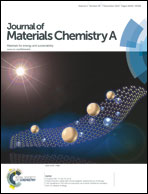Highly mesoporous carbons derived from biomass feedstocks templated with eutectic salt ZnCl2/KCl
Abstract
Highly mesoporous carbons (MCs) were prepared by the carbonization of biomass sources, including glucose, cellulose, and lignin, with eutectic salt (KCl/ZnCl2, denoted as PZ) as the porogen agent and catalyst. The influences of the mass ratio of carbon sources to PZ, the heating program, and the calcination temperature on the textural structures of the carbons were investigated. It was demonstrated that the MC derived from glucose with a mass ratio of glucose to PZ of 1 : 6 exhibited a specific surface area (SSA) of 1297 m2 g−1 and a pore volume of 2.727 cm3 g−1 dominated with a mesopore volume proportion of 92.2% and that the MCs from cellulose and lignin also showed relatively high mesoporous proportions in the range of 63.2–87.5% and SSAs higher than 1000 m2 g−1. Furthermore, based on the TGA, FT-IR and N2 sorption analyses, the generation of a high proportion of mesopores in MCs was also studied.


 Please wait while we load your content...
Please wait while we load your content...